
Roy Fox Lichtenstein was an American pop artist. During the 1960s, along with Andy Warhol, Jasper Johns, and James Rosenquist, he became a leading figure in the new art movement. His work defined the premise of pop art through parody. Inspired by the comic strip, Lichtenstein produced precise compositions that documented while they parodied, often in a tongue-in-cheek manner. His work was influenced by popular advertising and the comic book style. His artwork was considered to be "disruptive". He described pop art as "not 'American' painting but actually industrial painting". His paintings were exhibited at the Leo Castelli Gallery in New York City.

The National Gallery of Art Sculpture Garden is the most recent addition to the National Gallery of Art in Washington, D.C. in the United States. It is located on the National Mall between the National Gallery's West Building and the Smithsonian Institution's National Museum of Natural History.

Whaam! is a 1963 diptych painting by the American artist Roy Lichtenstein. It is one of the best-known works of pop art, and among Lichtenstein's most important paintings. Whaam! was first exhibited at the Leo Castelli Gallery in New York City in 1963, and purchased by the Tate Gallery, London, in 1966. It has been on permanent display at Tate Modern since 2006.

Little Big Painting is a 1965 oil and Magna on canvas pop art painting by Roy Lichtenstein. It is part of the Brushstrokes series of artworks that include several paintings and sculptures. It is located at the Whitney Museum of American Art in New York City. As with all of his Brushstrokes works, it is in part a satirical response to the gestural painting of abstract expressionism.

El Cap de Barcelona (1991–1992) is a surrealist sculpture created by American Pop artist Roy Lichtenstein for the 1992 Summer Olympics in Barcelona, Catalonia, Spain. Its English title is The Head of Barcelona.
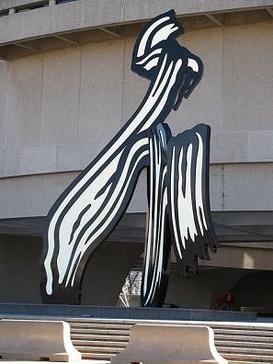
Brushstroke is a sculpture by Roy Lichtenstein. There are two copies. The original was created in 2001 for the Museo Nacional Centro de Arte Reina Sofía in Madrid, Spain. The second was delivered to the Hirshhorn Museum and Sculpture Garden in Washington, DC, on September 16, 2003, and dedicated on October 25, 2003.

House I is a sculpture by Roy Lichtenstein. It has an illusion, which makes it appear inside out, or normally, depending on which way the viewer sees it.
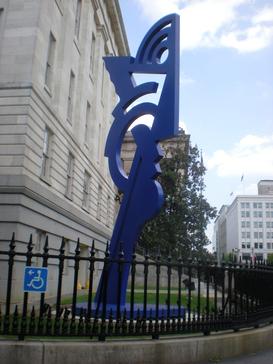
Modern Head is the name given to five extant 31-foot tall steel sculptures by Roy Lichtenstein. It has sometimes been claimed that the artist produced Modern Head as an edition of four sculptures; however, this is incorrect.

Look Mickey is a 1961 oil on canvas painting by Roy Lichtenstein. Widely regarded as the bridge between his abstract expressionism and pop art works, it is notable for its ironic humor and aesthetic value as well as being the first example of the artist's employment of Ben-Day dots, speech balloons and comic imagery as a source for a painting. The painting was bequeathed to the Washington, D.C., National Gallery of Art upon Lichtenstein's death.
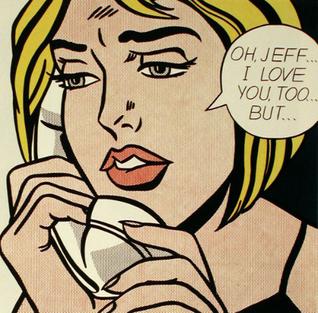
Oh, Jeff...I Love You, Too...But... is a 1964 oil and magna on canvas painting by Roy Lichtenstein. Like many of Lichtenstein's works its title comes from the speech balloon in the painting.
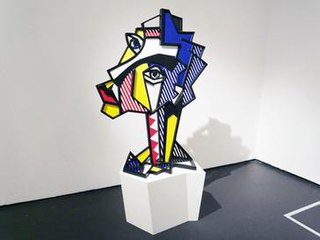
Expressionist Head by pop artist Roy Lichtenstein is the name associated with several 1980s works of art. It is widely associated with a set of six identical sculptures but is also associated with a series of paintings.

Big Painting No. 6 is a 1965 oil and Magna on canvas painting by Roy Lichtenstein. Measuring 235 cm × 330 cm, it is part of the Brushstrokes series of artworks that includes several paintings and sculptures whose subject is the actions made with a house-painter's brush. It set a record auction price for a painting by a living American artist when it sold for $75,000 in 1970. The painting is in the Kunstsammlung Nordrhein-Westfalen collection.
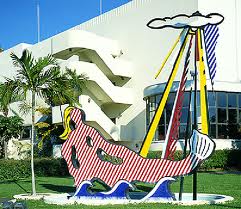
Mermaid is a 1979 outdoor sculpture by Roy Lichtenstein, composed of concrete, steel, polyurethane, enamel, palm tree, and water. It is located in Miami Beach at the Fillmore Miami Beach at Jackie Gleason Theater. Measuring 640 cm × 730 cm × 330 cm, it is his first public art commission according to some sources, although others point to a temporary pavilion that predates this work. It is also the second piece of public art in the city of Miami Beach. Since the sculpture was installed, it has been restored several times, and the theater that it accompanies has been restored and renamed twice.
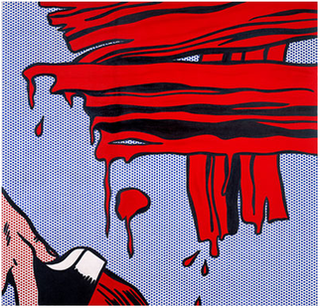
Brushstrokes series is the name for a series of paintings produced in 1965-1966 by Roy Lichtenstein. It also refers to derivative sculptural representations of these paintings that were first made in the 1980s. In the series, the theme is art as a subject, but rather than reproduce masterpieces as he had starting in 1962, Lichtenstein depicted the gestural expressions of the painting brushstroke itself. The works in this series are linked to those produced by artists who use the gestural painting style of abstract expressionism made famous by Jackson Pollock, but differ from them due to their mechanically produced appearance. The series is considered a satire or parody of gestural painting by both Lichtenstein and his critics. After 1966, Lichtenstein incorporated this series into later motifs and themes of his work.

Yellow and Green Brushstrokes is a 1966 oil and Magna on canvas pop art painting by Roy Lichtenstein. It is part of the Brushstrokes series of artworks that includes several paintings and sculptures. It is located at the Museum für Moderne Kunst in Frankfurt, Germany. As with all of his Brushstrokes works, it is in part a satirical response to the gestural painting of Abstract Expressionism. It is in the collection of the Museum für Moderne Kunst.

Brushstrokes is a 1965 oil and Magna on canvas pop art painting by Roy Lichtenstein. It is the first element of the Brushstrokes series of artworks that includes several paintings and sculptures. As with all of his Brushstrokes works, it is in part a satirical response to the gestural painting of Abstract Expressionism.

Brushstrokes is a 1996 sculpture by Roy Lichtenstein, installed outside the Portland Art Museum's Mark Building, in Portland, Oregon. It is part of the Brushstrokes series of artworks that includes several paintings and sculptures whose subject is the actions made with a house-painter's brush.
Five Brushstrokes is a 1984 sculpture from the Brushstrokes series by Roy Lichtenstein that was fabricated in 2010 and acquired by the New Orleans Museum of Art in 2013. It was installed in a fountain at the entrance of the museum in City Park. The painted and fabricated aluminum sculpture is a gift of Sydney and Walda Besthoff and Partial Gift of the Roy Lichtenstein Foundation.
Five Brushstrokes is a 1983–84 sculpture series from the Brushstrokes series by Roy Lichtenstein that was fabricated in 2012 and acquired by the Indianapolis Museum of Art in 2013. It was installed in front of the entrance of the main building of the museum. The painted and fabricated aluminum and steel sculptural series is a gift of the Robert L. and Marjorie J. Mann Fund and partial gift of the Roy Lichtenstein Foundation. The first showing of Element E of the series was displayed in the rotunda of the Tweed Courthouse in 2003 as part of a Lower Manhattan public art exhibit.
Tokyo Brushstroke I and II, or Tokyo Brushstrokes, refers to two 1994 aluminum sculptures by Roy Lichtenstein. Copies are installed outside Shinjuku I-Land Co, Ltd., in Tokyo, Japan, and at the Parrish Art Museum in Watermill, New York.














